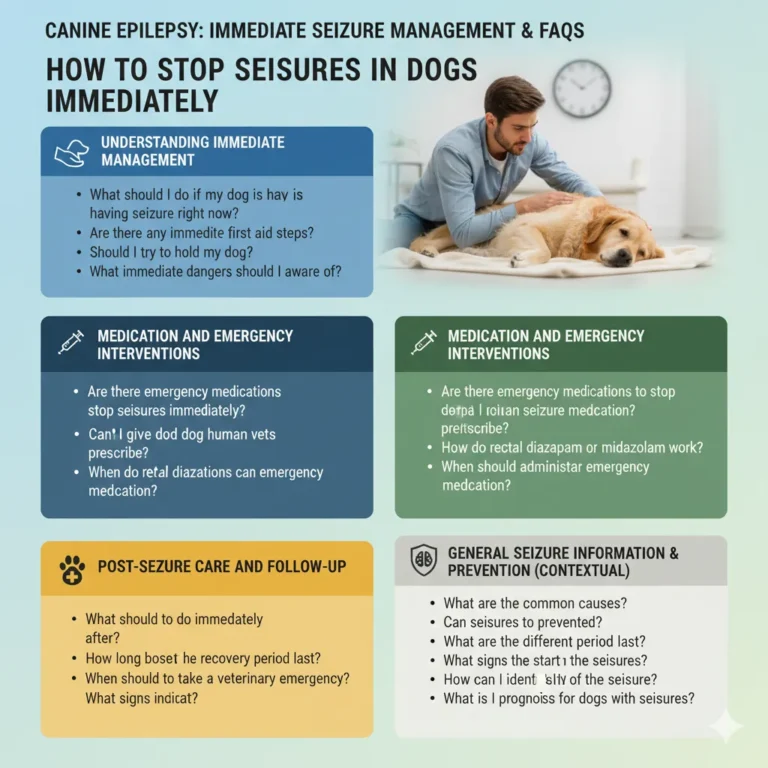
how to stop seizures in dogs immediately
Hey there, fellow dog lover! Have you ever been curled up on the couch with your best furry friend, everything perfectly normal, when suddenly… the world flips upside down? Out of nowhere, your dog isn’t your dog anymore. They’re shaking, confused, and completely out of control. It’s heart-stopping, terrifying, and in that moment, you’d give anything to know how to make it stop.
I’ve been there. My own golden retriever, Barnaby, is an epileptic, and let me tell you, the first time I saw him have a seizure, I was a complete mess. I want to share that knowledge with you, not to scare you, but to empower you. This isn’t just a clinical guide; it’s a chat from one dog parent to another about what to do when every single second counts. We’ll walk through the immediate steps, talk about emergency meds your vet might prescribe, and figure out when it’s time to sound the alarms and rush to the vet. Consider this your go-to, friendly manual for navigating one of the scariest moments in dog ownership.
Notice: You will find the sources at the end of the article.
Understanding Immediate Seizure Management
Okay, let’s get right into it. Your dog is seizing. Your heart is pounding. What now? The most important thing to understand is that your main job isn’t to stop the seizure itself—that electrical storm in the brain usually has to run its course. Your job is to be their guardian, their safety net. Think of yourself as their personal lifeguard; you’re there to make sure they don’t get hurt while their brain is temporarily offline.
What should I do if my dog is having a seizure right now?
First things first: take a deep, calming breath. I know, I know, it feels impossible. But your pup needs you to be their calm in the storm. Your panic won’t help them, but your clear-headedness will.
Next, do a quick scan of the area. Is there a coffee table with a sharp corner nearby? Are they on the stairs? Your mission is to create a safe bubble around them. Gently slide furniture away, put pillows around them if they’re thrashing against a hard floor, and if they’re on a high surface like a bed, carefully guide them to the floor if you can do it safely.
How can I stop a dog seizure once it starts?
This is the tough love part, friends. There is no safe way for you to physically stop a seizure once it has started. It’s a neurological event, like a computer crashing. You can’t just hit Control-Alt-Delete on your pup. Trying to shake them or yell their name to “snap them out of it” doesn’t work and can actually make things more stressful for them. The kindest thing you can do is focus on safety and let the episode pass, which it usually does in a minute or two.
Are there any immediate first aid steps for a dog having a seizure?
Absolutely! While you’re being their safety manager, here’s your quick first-aid checklist:
- Become a Timekeeper: Grab your phone or glance at a clock. Timing the seizure is one of the most critical pieces of info for your vet. If it goes on for more than five minutes, it’s a full-blown emergency.
- Hands Off the Mouth: I need you to trust me on this. Your dog cannot swallow their tongue. Trying to put something in their mouth or pull their tongue out is a one-way ticket to a serious bite injury. Those jaws clamp down with incredible, involuntary force.
- Dial Down the Drama: Turn down bright lights, mute the TV, and ask any panicked family members to step back. A calm, quiet, dim environment can help. You can talk to them in a soft, soothing voice, but don’t overwhelm them.
- Just Be There: Your calm presence matters. Stay with them, talk softly, and let them know they’re not alone.
What is the fastest way to stop a dog seizure?
So, if we can’t stop it ourselves, is there any fast way? Well, for dogs like my Barnaby who have a known history, your vet might prescribe what I call a “seizure rescue kit.” This usually involves fast-acting rectal or intranasal medication that you can administer at home to short-circuit a prolonged seizure. It’s not an instant off-switch, but it’s the closest thing we have. We’ll geek out about these medications in just a bit!
Should I try to hold my dog during a seizure?
Nope, please don’t. I get the urge to hug them and make it all better, but a seizing dog isn’t in control. They might thrash and accidentally clock you in the face or bite you. Even worse, holding them down can increase their stress and potentially cause them to injure a muscle or joint fighting against you. Your job is to protect the space around them, not to restrain them.
What immediate dangers should I be aware of during a dog seizure?
While you’re in guardian mode, keep an eye out for these specific hazards:
- The Bump-and-Bruise Department: Hard surfaces, sharp corners, and stairways are the biggest threats. That’s why clearing the area is your number one task.
- Overheating: A long seizure (more than a few minutes) can send their body temperature soaring. If a seizure drags on, you can gently place a cool towel on their paws or groin after it ends, but your vet will likely need to manage this directly.
- The Choking Myth (Revisited): Again, they won’t choke on their tongue, but if they vomit, there’s a small risk of breathing it in. This is another reason to keep them on their side and leave their mouth alone.
- Self-Inflicted Ouchies: Sometimes they can bite their own tongue or cheek. It looks scary, but it’s usually minor. Still, don’t risk your fingers to try and prevent it.
Medication and Emergency Interventions
Alright, let’s talk about the superhero tools in our arsenal: emergency medications. These aren’t for everyday use, but for those “oh-no, this is a bad one” moments. If your dog is prone to clusters or long seizures, having a plan with your vet is a total game-changer.
Are there emergency medications to stop dog seizures immediately?
You bet! For our seizure-prone pups, vets can prescribe fast-acting medications designed specifically for home use. These are typically from a family of drugs called benzodiazepines, which are like a calming blanket for an overexcited brain.
- Rectal Diazepam (Valium): This is the old reliable. It’s a gel administered rectally, where it’s absorbed super quickly into the bloodstream. It might feel a little awkward at first, but when you see it help your dog, you’ll be so grateful for it.
- Intranasal Midazolam (Versed): This is another great option that’s sprayed into the nostril. It can be a bit easier to administer, especially with a wiggly or anxious dog.
Big, important disclaimer: You should only ever use these under the direct guidance and prescription of your veterinarian. They will walk you through exactly when and how to use them.
Can I give my dog human seizure medication in an emergency?
Absolutely not. Do not pass go, do not collect $200. This is so important. Human medications are dosed and formulated for human bodies. Giving your dog even a tiny piece of a human seizure pill could be ineffective at best and deadly at worst. Always, always, always work with your vet.
What fast-acting medications can vets prescribe for emergency seizure control?
At the veterinary clinic, they have even more tools! They can give medications directly into a vein (IV) for an almost immediate effect. These can include IV versions of diazepam or midazolam, or other powerful drugs like phenobarbital, levetiracetam (Keppra), or even anesthetics like propofol in extreme cases. They have the training and equipment to handle a seizing dog safely.
For the real science lovers, organizations like the American College of Veterinary Internal Medicine (ACVIM) publish in-depth guidelines that vets follow, which you can sometimes find online if you search for “ACVIM consensus statement canine epilepsy.”
How do rectal diazepam or midazolam work for immediate seizure control?
Let’s nerd out for a second! Imagine your dog’s brain is having a massive, out-of-control party (the seizure). These medications work by inviting the brain’s best bouncer, a neurotransmitter called GABA, to the party. GABA’s job is to calm everything down. Benzodiazepines like diazepam and midazolam basically give GABA a megaphone, allowing it to shut down the chaotic electrical firing and restore order. The rectal or intranasal route gets this “bouncer” to the “party” in the brain as fast as possible.
When should I administer emergency seizure medication?
This isn’t a “you’ll know it when you see it” situation. You must have a crystal-clear plan from your vet. Generally, the red flags for using rescue meds are:
- A seizure that lasts longer than a set time (often 3-5 minutes).
- If they have more than one seizure in a 24-hour period (cluster seizures).
- If the seizure is dramatically more violent or severe than their usual ones.
Your vet will give you the specific “if this, then that” instructions for your unique dog.
Post-Seizure Care and Follow-up
Phew. The seizure is over. But your dog isn’t back to normal yet. They’re entering what’s called the post-ictal phase. This is like the confusing hangover after the brain’s wild party. They might be disoriented, wobbly, temporarily blind, or even a little agitated.
What should I do immediately after my dog has a seizure?
This is the time for gentle TLC.
- Keep the Vibe Chill: The world is still too much for them. Keep the lights low and the noise down.
- Offer a Drink: They’re often incredibly thirsty. Have a bowl of fresh water ready and let them sip at their own pace.
- Be Their Guide: If they’re bumping into walls, gently steer them away from obstacles. Don’t force cuddles if they seem spacey or want to be alone.
- Play Detective: Keep a close watch on them. Note how long this confused state lasts and what they do. This is all valuable intel for your vet.
- Clean Up Calmly: If there was an accident, clean it up quietly without a fuss.
How long does the recovery period last after a dog seizure?
It really depends on the dog and the seizure. For a short one, Barnaby is sometimes back to his old self in 10 minutes. After a bigger one, he might be spaced out and clingy for a few hours. In severe cases, it can last a full day or more. Their brain is basically rebooting, so patience is everything.
When should I take my dog to the vet after a seizure?
You don’t always need to race to the ER after a single, short seizure, especially if your dog has a known condition. But you should call your vet or an emergency clinic immediately if:
- The seizure lasts longer than 5 minutes.
- They have two or more seizures in a short period (cluster seizures).
- It’s their first seizure ever! (This is a big one—we need to find out why).
- They seem injured or are in visible pain.
- The post-ictal phase is super intense—extreme disorientation, aggression, or a high fever that won’t break.
- You used the emergency med and it didn’t work.
- They’re having trouble breathing.
When in doubt, pick up the phone. It’s always better to be safe.
What signs indicate a veterinary emergency after a seizure?
Beyond the seizure itself, watch for these red flags in the recovery period:
- Can’t find their way around: Prolonged disorientation or blindness where they are consistently crashing into things.
- Struggling to breathe: Any gasping, wheezing, or blue-tinged gums is a major emergency.
- Running a fever: If they still feel dangerously hot to the touch long after the seizure.
- Non-stop vomiting or diarrhea.
- Can’t stand or walk, or cries out in pain.
- Just not “back.” If they don’t seem to be improving after a reasonable amount of time.
Trust your gut. You know your dog better than anyone.
General Seizure Information and Prevention (Contextual)
Let’s zoom out a bit and talk about the bigger picture. Understanding the “why” behind seizures can help you feel more in control and be a better partner to your vet.
What are the common causes of seizures in dogs?
It’s a long list, which is why diagnosis can be a process of elimination.
- Idiopathic Epilepsy: The most common culprit! This is a fancy way of saying “we don’t know the exact cause, but it’s probably genetic.” It often shows up in young to middle-aged dogs. Breeds like Labs, Shepherds, and Goldens are more prone.
- Brain Stuff: This includes tumors, strokes, or past head trauma.
- Metabolic Mayhem: Problems outside the brain, like a failing liver, low blood sugar, or a thyroid issue, can mess with brain function.
- Toxins: Eating something they shouldn’t have, like certain pesticides, human drugs, or toxic foods.
- Infections: Things like distemper or other brain inflammations.
Figuring it out usually starts with blood work and can sometimes lead to an MRI of the brain.
Can seizures be prevented in dogs?
It depends on the cause.
- For Idiopathic Epilepsy: You can’t prevent the condition, but you can manage it brilliantly with daily medication to reduce the number and severity of seizures.
- For other causes:
- Toxins: Be a hawk about what they can get into! Prevention is 100% key.
- Metabolic issues: Managing the root disease (like diabetes) often controls the seizures.
- Structural problems: Treating the underlying issue (e.g., with surgery or meds for a tumor) is the path to prevention.
So, while we can’t always prevent the first seizure, we can absolutely work to prevent the next one.
What are the different types of dog seizures?
They don’t all look like the classic “grand mal.” Here’s the rundown:
- Generalized Seizures (Grand Mal): The full-body event. Loss of consciousness, paddling, chomping, the works.
- Focal Seizures: These are more subtle and can be tricky to spot.
- Simple Focal: Just one part of the body twitches (like an eyelid or a leg), but they’re still “with you.”
- Complex Focal: Their consciousness is altered. They might stare into space, snap at the air, or run in circles for no reason. These are often mistaken for weird behavioral quirks.
- Cluster Seizures: Several seizures in one day.
- Status Epilepticus: A continuous seizure lasting more than 5 minutes. This is a 911-level emergency.
How can I identify the start of a seizure?
Some dogs give little warning signs, called an aura or prodrome. Barnaby gets super clingy and starts panting. Watch for things like:
- Restlessness, anxiety, or hiding.
- Whining or seeking attention.
- Staring into space or drooling.
Not all dogs do this, but if yours does, it’s a valuable heads-up to get them to a safe space.
What is the prognosis for dogs with seizures?
This is the question we all ask, and the answer is generally hopeful! For dogs with idiopathic epilepsy, with consistent medication and a great partnership with your vet, the prognosis for a long, happy life is excellent. The goal is management, not necessarily a cure. For seizures from other causes, the prognosis depends on treating that underlying issue. It’s a journey, for sure, but one you don’t have to walk alone. With love, patience, and great veterinary care, your pup can still have a wonderful, wag-filled life.
please leave comment
you may like it





sources
- https://www.vet.cornell.edu/departments-centers-and-institutes/riney-canine-health-center/canine-health-information/managing-seizures
- https://pmc.ncbi.nlm.nih.gov/articles/PMC11209469/
- https://www.msdvetmanual.com/pharmacology/systemic-pharmacotherapeutics-of-the-nervous-system/anticonvulsants-for-emergency-treatment-of-seizures-in-dogs-and-cats
- https://www.webmd.com/pets/dogs/dog-seizure-disorders
- https://www.petmd.com/dog/symptoms/seizures-in-dogs
- https://www.pdsa.org.uk/pet-help-and-advice/pet-health-hub/other-veterinary-advice/first-aid-for-fitsseizures-in-pets
- https://vetmed.auburn.edu/wp-content/uploads/2019/10/8_Emergency-Seizures_PLATT-1.pdf
- https://www.frontiersin.org/journals/veterinary-science/articles/10.3389/fvets.2023.1278618/full
- https://chappellevet.ca/how-to-manage-a-dog-or-cat-that-is-having-seizures/
- https://firstaidforpets.net/dog-seizures-how-to-help%EF%BB%BF/

